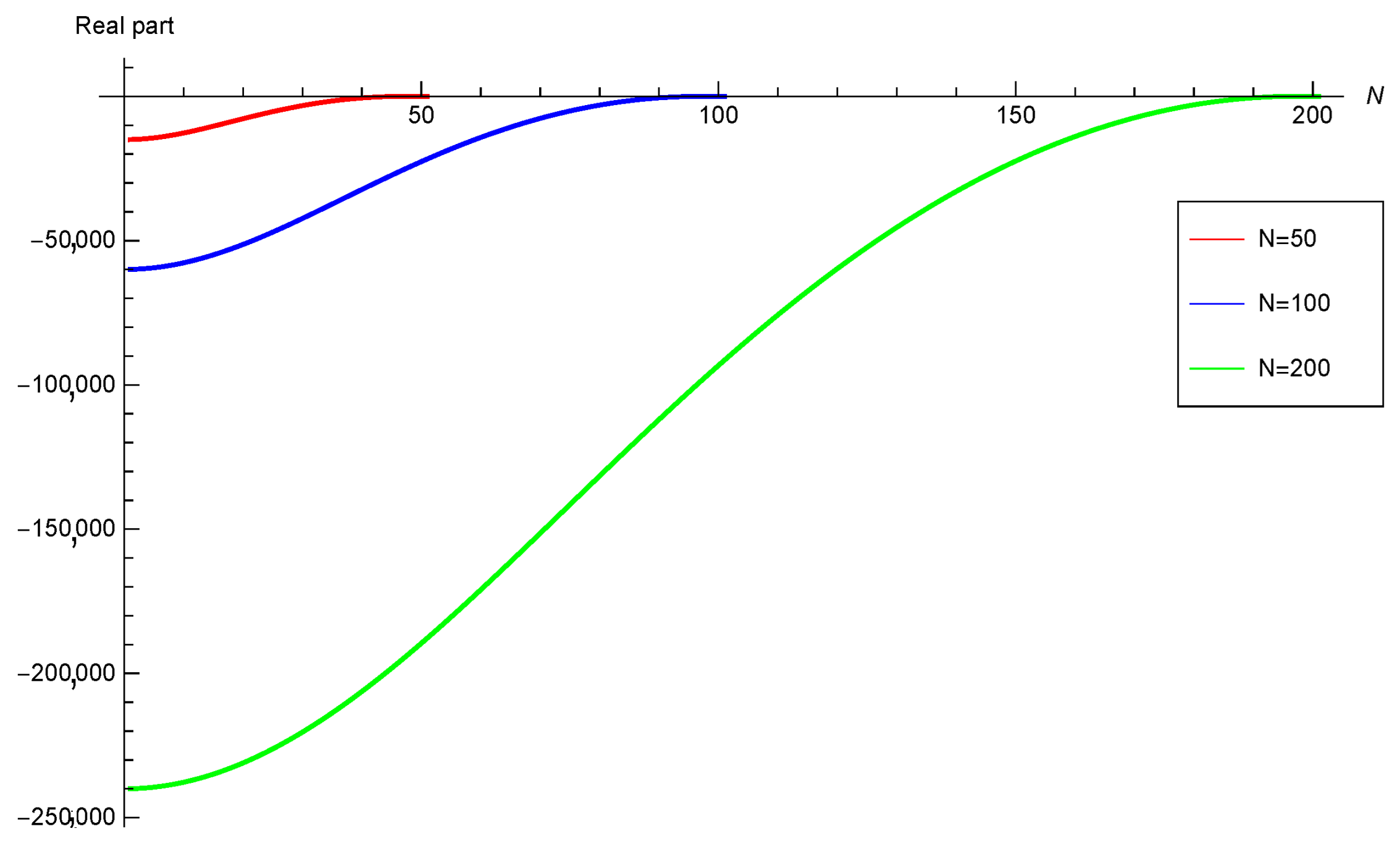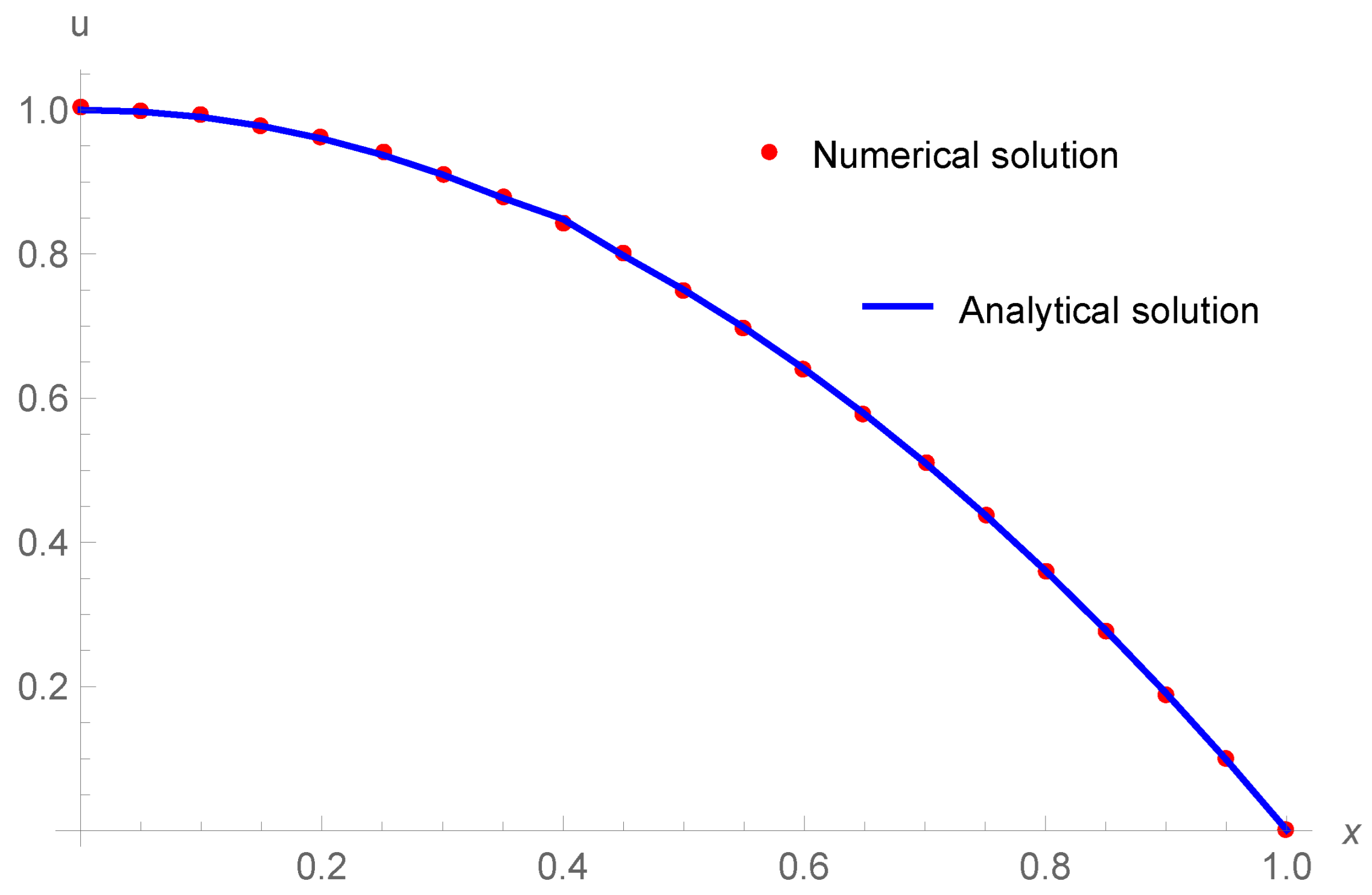A Five-Step Block Method Coupled with Symmetric Compact Finite Difference Scheme for Solving Time-Dependent Partial Differential Equations
Abstract
:1. Introduction
2. Development of a Five-Step Block Method
3. Basic Characteristics of the Method and Stability Analysis
3.1. Order of Accuracy and Consistency
3.2. Zero Stability
3.3. Linear Stability Analysis
4. Symmetric Compact Finite Difference Scheme
5. Test Problems
5.1. Burgers’ Equation
5.2. FitzHugh–Nagumo Equation
5.3. Stability of Differential System
6. Numerical Experiments
6.1. Nonlinear Burgers’ Equation
6.1.1. Example 1
6.1.2. Example 2
6.2. Non-Linear FitzHugh–Nagumo Equation
6.2.1. Example 1
6.2.2. Example 2
6.3. PDE with Manufactured Solution
7. Conclusions
Author Contributions
Funding
Data Availability Statement
Acknowledgments
Conflicts of Interest
References
- Debnath, L. Nonlinear Partial Differential Equations for Scientists and Engineers; Birkhauser: Basel, Switzerland, 2012. [Google Scholar]
- Collatz, L. The Numerical Treatment of Differential Equations, 1st ed.; Springer: Berlin/Heidelberg, Germany, 1966. [Google Scholar]
- Li, H.-B.; Song, M.-Y.; Zhong, E.-J.; Gu, X.-M. Numerical Gradient Schemes for Heat Equations Based on the Collocation Polynomial and Hermite Interpolation. Mathematics 2019, 7, 93. [Google Scholar] [CrossRef]
- Luo, W.-H.; Huang, T.-Z.; Gu, X.-M.; Liu, Y. Barycentric rational collocation methods for a class of nonlinear parabolic partial differential equations. Appl. Math. Lett. 2017, 68, 13–19. [Google Scholar] [CrossRef]
- Mehta, A.; Singh, G. Solving one-dimensional third order nonlinear KdV equation using MacCormack method coupled with compact finite difference scheme. AIP Conf. Proc. 2022, 2451, 020064. [Google Scholar]
- Parvizi, M.; Khodadadian, A.; Eslahchi, M.R. A mixed finite element method for solving coupled wave equation of Kirchhoff type with nonlinear boundary damping and memory term. Math. Method Appl. Sci. 2021, 44, 12500–12521. [Google Scholar] [CrossRef]
- Parvizi, M.; Khodadadian, A.; Eslahchi, M.R. Analysis of Ciarlet-Raviart mixed finite element methods for solving Boussinesq equation. J. Comput. Appl. Math. 2020, 379, 112818. [Google Scholar] [CrossRef]
- Butcher, J.C. Numerical Methods for Ordinary Differential Equations, 2nd ed.; John Wiley & Sons: Hoboken, NJ, USA, 2008. [Google Scholar]
- Akkoyunlu, C. Compact finite difference method for Fitz-Hugh-Nagumo equation. Univ. J. Math. Appl. 2019, 4, 180–187. [Google Scholar] [CrossRef]
- Agbavon, K.M.; Appadu, A.R. Construction and analysis of some nonstandard finite difference methods for the Fitz-Hugh-Nagumo equation. Numer. Differ. Equ. 2020, 36, 1145–1169. [Google Scholar] [CrossRef]
- Jiwari, R.; Gupta, R.; Kumar, V. Polynomial differential quadrature method for numerical solutions of the generalized Fitzhugh-Nagumo equation with time-dependent coefficients. Ain Shams Eng. 2014, 5, 1343–1350. [Google Scholar] [CrossRef]
- Jiwari, R. A haar wavelet quasilinearization approach for numerical simulation of Burgers’ equation. Comput. Phys. Commun. 2012, 183, 2413–2423. [Google Scholar] [CrossRef]
- Jiwari, R. A hybrid numerical scheme for the numerical solution of Burgers’ equation. Comput. Phys. Commun. 2015, 188, 59–67. [Google Scholar] [CrossRef]
- Benton, E.; Platzman, G.W. A table of solutions of the one-dimensional Burgers’ equations. Quart. Appl. Math. 1972, 30, 195–212. [Google Scholar] [CrossRef]
- Zhang, P.G.; Wang, J.P. A predictor-corrector compact finite difference scheme for Burgers’ equation. Appl. Math. Comput 2012, 219, 892–898. [Google Scholar] [CrossRef]
- Sari, M.; Gurarslan, G. A sixth-order compact finite difference scheme to numerical solution of Burgers’ equation. Appl. Math. Comput. 2009, 208, 475–483. [Google Scholar] [CrossRef]
- Gao, F.; Chi, C. Numerical solution of non-linear Burgers’ equation using high accuracy multi-quadric quasi interpolation. Appl. Math. Comput. 2014, 229, 414–421. [Google Scholar] [CrossRef]
- Hassanian, I.A.; Salama, A.A.; Hosham, H.A. Fourth-order finite difference method for solving Burgers’ equation. Appl. Math. Comput. 2005, 170, 892–898. [Google Scholar] [CrossRef]
- Yang, X.; Ge, Y.; Zhang, L. A class of high-order compact difference schemes for solving the Burgers’ equation. Appl. Math. Comput. 2019, 358, 394–417. [Google Scholar] [CrossRef]
- Mittal, R.C.; Jain, R.K. Numerical solution of non-linear Burgers’ equation with modified cubic b-splines collocation method. Appl. Math. Comput. 2012, 358, 7839–7855. [Google Scholar] [CrossRef]
- Gulsu, M. A finite difference approach for solution of Burgers’ equation. Appl. Math. Comput. 2006, 175, 1245–1255. [Google Scholar] [CrossRef]
- Lele, S.K. Compact finite difference schemes with spectral-like resolution. J. Comput. Phys. 1992, 103, 16–42. [Google Scholar] [CrossRef]
- Zhao, J. Highly accurate compact mixed methods for two point boundary value problems. Appl. Math. Comput. 2017, 188, 1402–1418. [Google Scholar] [CrossRef]
- Milne, W.E. Numerical Solution of Differential Equations; Wiley: New York, NY, USA, 1953; Volume 9. [Google Scholar]
- Lambert, J.D. Computational methods in ordinary differential equations. In Introductory Mathematics for Scientists and Engineers; Wiley: New York, NY, USA, 1973; Volume 54. [Google Scholar]
- Harrier, E.; Wanner, G. Solving Ordinary Differential Equations-II: Stiff and Differential-Algebraic Problems; Springer: Berlin/Heidelberg, Germany, 1996. [Google Scholar]
- Tyler, G.J. Analysis and Implementation of High-Order Compact Finite Difference Schemes. Master’s Thesis, Brigham Young University, Provo, UT, USA, 2007. [Google Scholar]
- Mehra, M.; Patel, K.S. A suite of Compact Finite Difference Schemes. ACM Trans. Math. Softw. 2017, 44, 1–31. [Google Scholar] [CrossRef]
- Erdogan, L.; Sakar, M.G.; Saldir, O. A finite difference method on layer-adapted mesh for singularly perturbed delay differential equations. Appl. Math. Nonlinear Sci. 2020, 5, 425–436. [Google Scholar] [CrossRef]
- Jain, M.K.; Iyengar, S.R.K.; Jain, R.K. Computational methods for partial differential equations. New Age Int. Publ. 2016, 5, 425–436. [Google Scholar]
- Asai, A. Numerical solution of the Burgers’ equation by automatic differentiation. Appl. Math. Comput. 2010, 216, 2700–2708. [Google Scholar]
- Ahmad, I.; Ahsan, M.; Din, Z.U. An efficient local formulation for time-dependent PDEs. Mathematics 2019, 7, 216. [Google Scholar] [CrossRef]
- Inan, B.; Ali, K.K.; Saha, A.; Ak, T. Analytical and numerical solutions of the Fitz Hugh–Nagumo equation and their multistability behavior. Numer. Methods Partial. Differ. Equ. 2020, 37, 7–23. [Google Scholar] [CrossRef]





| x | Absolute Error |
|---|---|
| 0.1 | 4.6342 × |
| 0.2 | 1.4033 × |
| 0.3 | 1.9936 × |
| 0.4 | 1.2330 × |
| 0.5 | 4.9473 × |
| 0.6 | 2.3491 × |
| 0.7 | 3.8157 × |
| 0.8 | 6.0069 × |
| 0.9 | 1.5378 × |
| x | Absolute Error (Asai [31]) | Absolute Error (Mittal [20]) | Absolute Error (The Proposed Scheme) |
|---|---|---|---|
| 0.1 | 4.50 × | 7.40 × | 3.84 × |
| 0.2 | 7.70 × | 6.00 × | 5.45 × |
| 0.3 | 1.21 × | 1.20 × | 6.79 × |
| 0.4 | 2.40 × | 1.78 × | 1.23 × |
| 0.5 | 2.53 × | 3.90 × | 4.41 × |
| 0.6 | 3.56 × | 4.40 × | 1.63 × |
| 0.7 | 4.84 × | 1.00 × | 2.53 × |
| 0.8 | 3.32 × | 7.40 × | 3.48 × |
| 0.9 | 4.17 × | 2.81 × | 7.86 × |
| x | Absolute Error (Asai [31]) | Absolute Error (Mittal [20]) | Absolute Error (The Proposed Scheme) |
|---|---|---|---|
| 0.1 | 4.00 × | 0.000000 | 5.76 × |
| 0.2 | 9.00 × | 2.00 × | 1.47 × |
| 0.3 | 1.40 × | 3.00 × | 1.96 × |
| 0.4 | 2.20 × | 6.00 × | 2.82 × |
| 0.5 | 3.20 × | 1.00 × | 9.95 × |
| 0.6 | 4.90 × | 1.20 × | 4.02 × |
| 0.7 | 7.50 × | 7.50 × | 6.72 × |
| 0.8 | 4.50 × | 1.00 × | 1.58 × |
| 0.9 | 8.10 × | 7.40 × | 3.35 × |
| N | -Error | ROC |
|---|---|---|
| 40 | 8.08777 × | |
| 80 | 9.97993 × | 3.0186 |
| 160 | 3.83759 × | 4.7008 |
| 320 | 1.69230 × | 4.5031 |
| N | -Error with CPU (sec.) (The Proposed Scheme) | (Method in Akkoyunlu [9]) |
|---|---|---|
| 12 | 6.3673 × | 3.9857 × |
| (0.65) | ||
| 24 | 4.7712 × | 2.3475 × |
| (2.34) | ||
| 48 | 8.0504 × | 8.3749 × |
| (9.60) | ||
| 64 | 4.7818 × | 5.9363 × |
| (17.75) | ||
| No. of iterations | 4 | 20 |
| Ahmad [32] | Jiwari [11] | The Proposed Scheme | |
|---|---|---|---|
| -Errorh | -Error | -Error with CPU (sec.) | |
| 0.2 | 2.1960 × | 1.5880 × | 4.0099 × |
| (47.89) | |||
| 0.5 | 1.5696 × | 3.8433 × | 2.8629 × |
| (125.23) | |||
| 1.0 | 7.1449 × | 8.1870 × | 1.3175 × |
| (268.56) | |||
| 1.5 | 1.7262 × | 1.3387 × | 3.2282 × |
| (395.18) | |||
| 2 | 3.1857 × | 1.9433 × | 6.1114 × |
| (527.95) | |||
| time step-size(k) | 0.0001 | 0.001 | 0.01 |
Disclaimer/Publisher’s Note: The statements, opinions and data contained in all publications are solely those of the individual author(s) and contributor(s) and not of MDPI and/or the editor(s). MDPI and/or the editor(s) disclaim responsibility for any injury to people or property resulting from any ideas, methods, instructions or products referred to in the content. |
© 2024 by the authors. Licensee MDPI, Basel, Switzerland. This article is an open access article distributed under the terms and conditions of the Creative Commons Attribution (CC BY) license (https://creativecommons.org/licenses/by/4.0/).
Share and Cite
Kaur, K.; Singh, G.; Ritelli, D. A Five-Step Block Method Coupled with Symmetric Compact Finite Difference Scheme for Solving Time-Dependent Partial Differential Equations. Symmetry 2024, 16, 307. https://doi.org/10.3390/sym16030307
Kaur K, Singh G, Ritelli D. A Five-Step Block Method Coupled with Symmetric Compact Finite Difference Scheme for Solving Time-Dependent Partial Differential Equations. Symmetry. 2024; 16(3):307. https://doi.org/10.3390/sym16030307
Chicago/Turabian StyleKaur, Komalpreet, Gurjinder Singh, and Daniele Ritelli. 2024. "A Five-Step Block Method Coupled with Symmetric Compact Finite Difference Scheme for Solving Time-Dependent Partial Differential Equations" Symmetry 16, no. 3: 307. https://doi.org/10.3390/sym16030307





